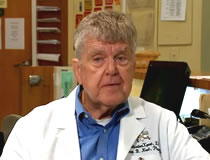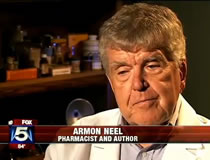September 6th, 2014
The Trouble with Serum Testosterone Testing (Important addition to Feb 2014 “I Told You So”
The Trouble with Serum Testosterone Testing
Here is a good explanation on how dealing with a drug prescriber without the competence to prescribe can lead you down the path to a fatal or severe outcome. In clear language "If you are over 50 years old and still have your testicles you don't need extra testosterone".
Take Note:
- Many clinical factors affect measured testosterone values, including diurnal variations, age, stress, common comorbid illnesses, and medications.
- Laboratory testing is not calibrated to a national standard, results vary widely between labs, and normal assay ranges have not been established.
- The diagnosis of hypogonadism should be based as much on signs and symptoms as on serum T measurement.
The assessment of possible hypogonadism in men is a growing part of urologic practice, and it’s fraught with clinical and laboratory challenges. In contrast to many other medical conditions, a specific laboratory value cannot be relied upon to confirm diagnosis and may result in unnecessary treatment of some asymptomatic men and undertreatment of men with persistent signs and symptoms despite apparently normal lab values.
- To address the current challenges to obtaining an accurate, relevant testosterone assay, the American Urologic Association released a White Paper on the laboratory diagnosis of testosterone deficiency.
- Published in Urology1 and available on the AUA web site, the White Paper describes the significant laboratory pitfalls in the diagnosis of hypogonadism and offers suggested workarounds until these obstacles are overcome.
Current obstacles to obtaining a trustworthy laboratory result begin with the problem that there is no agreed-upon normal assay level. No consensus exists about the definition of a “low” T level. While the Food and Drug Administration uses a cutoff of 300 ng/dL to define hypogonadism for clinical trials, a consensus statement from several professional societies recommends no treatment for patients with T levels above 350 ng/dL; treatment for levels below 230 ng/dL in symptomatic patients; and repeat testing for patients with levels between 230 and 350 ng/dL.
Strikingly, the White Paper Panel’s lead author, Darius A. Paduch, MD, PhD, Associate Professor of Urology and Reproductive Medicine and Director of Sexual Health and Medicine at Weill Cornell Medical College/New York Presbyterian Hospital, declares that published normal ranges are based on studies of men over 65.
“Our own published work and the work of others showed that testosterone levels are much higher in men between 20 and 40 than they are in men above 65. Intuitively and scientifically, it is true that a testosterone level for a 20-year-old college football player should not be the same as for his 80-year-old grandfather,” adds Dr. Paduch, noting that more research will be needed to identify age-adjusted testosterone levels for men, like those for estradiol in women.
Temporal variations add to the difficulty of setting a normal assay range. Serum T levels peak in the early morning (around 4AM to 5AM), decline throughout the day, and vary from day to day in the same person, making repeat testing especially important in patients with borderline results or results that don’t seem to fit with the patient’s clinical presentation.
Stress, age, comorbid illnesses (such as obesity, diabetes, depression, thyroid disorders), and certain medications (opiates and glucocorticoids, for example) affect testosterone levels. The effect is often indirect, via an impact on sex hormone-binding globulin (SHBG). Approximately 44% of total testosterone (TT) is bound to SHBG, but bound T is not bioavailable. Factors that increase SHBG, like aging, may lead to increased TT levels in men who are nonetheless hypogonadal because bioavailable T levels are below normal. Obesity and type 2 diabetes reduce SHBG and TT levels, and lab results may suggest that a patient has low TT levels although bioavailable T levels are in the normal range.
- “Testosterone levels can be decreased 25% within 30 minutes of stress and elevation in stress hormones like cortisol,”emphasizes Dr. Paduch.
Problems within laboratories make it impossible to compare results. “We sometimes see 30%-plus differences in testosterone levels obtained on the same day from the same patient but measured in 2 different laboratories,” says Dr. Paduch.
Preanalytic variables, such as type of collection tube, storage after centrifugation, and environmental conditions, can impact test results. Different laboratories use different testing methods--radioimmunoassay, immunoassay, and liquid chromatography-mass spectrometry (LC-MS/MS), the latter being the most precise, according to Dr. Paduch. The CDC Hormone Standardization Program reported that of 5 assays that passed the CDC standard for T testing, 4 were based on LC-MS/MS and a. was an immunoassay b. Clinicians may wish to consult with the laboratory director about collection tubes, transport, storage, and testing platform as well as use of the serum based materials for calibration offered through the CDC Hormone Standardization program.
The American Urological Association, the Endocrine Society, and the Centers for Disease Control are currently collaborating in an effort to standardize laboratory testing nationwide and identify age-adjusted normal assay ranges. Their work, currently in the analytical stage, will not be published for approximately 2 years, however.
Until then, what can the clinician do to assure that patients are correctly diagnosed and treated?
“At the end of the day, we are physicians and there is nothing better than a good history, thorough physical exam, and physician experience in the evaluation and treatment of men with low testosterone,” answers Dr. Paduch.
The White Paper’s final position statement echoes the recommendations of guidelines from the major professional associations,3-5 all of which call for a combination of clinical evaluation and consistent lab results to make the diagnosis: “On the basis of the extensive review of published data and input from professional organizations, the members of this panel believe that diagnosis of hypogonadism should be based as much on the presence of signs and symptoms as on serum T measurement. On the basis of overall poor quality of T testing in most clinical laboratories and age bias of published reference ranges, no patient should be denied coverage for treatment based solely on payer defined cutoff points if need for such treatment is established by a health professional.“1
Published: 08/19/2014
References:
Paduch DA, Brannigan RE, Fuchs EF, Kim ED, Marmar JL, Sandlow JI. The laboratory diagnosis of testosterone deficiency. Urology. 2014;83:980-988.
American Urological Association White Paper. (Available at: http://www.auanet.org/common/pdf/education/clinical-guidance/Testosterone-Deficiency-WhitePaper.pdf). Accessed Aug 1, 2014.
AACE Hypogonadism Task Force. American Association of Clinical Endocrinologists medical guidelines for clinical practice for the evaluation and treatment of hypogonadism in adult male patients – 2002 update. Endocrine Practice. 2002;8:439-456.
Bhasin S, Cunningham GR, Hayes FJ, et al; Task Force, Endocrine Society. Testosterone therapy in adult men with androgen deficiency syndromes: an Endocrine Society clinical practice guideline. J Clin Endocrinol Metab. 2010;95:2536–2559.
European Association of Urology. Guidelines on male hypogonadism. February 2012. Available at: http://www.uroweb.org/gls/pdf/18%20Male%20Hypogonadism_LR.pdf Accessed Aug 2, 2014.
- September 23rd, 2012
2 Beta-Blockers Similar for CV Event RiskRead - March 20th, 2015
ALERT .... DR. ARMON NEEL IS MUCH ALIVE AND PRACTICINGRead - August 18th, 2012
What would you do if you saw someone collapse?Read - July 3rd, 2015
Epilepsy Drug Could Reverse Early-Stage DementiaRead - September 9th, 2014
Wockhardt Recalls Blood Pressure DrugRead
Geriatric Nutrition
Without good nutrition, positive drug therapy outcomes are very difficult to obtain, For the best in Geriatric Nutritional Information
Find out more Optima SolutionsContinuing Education
Each month we will post an analysis of specific aspects of government long-term healthcare regulations.
Find out more


